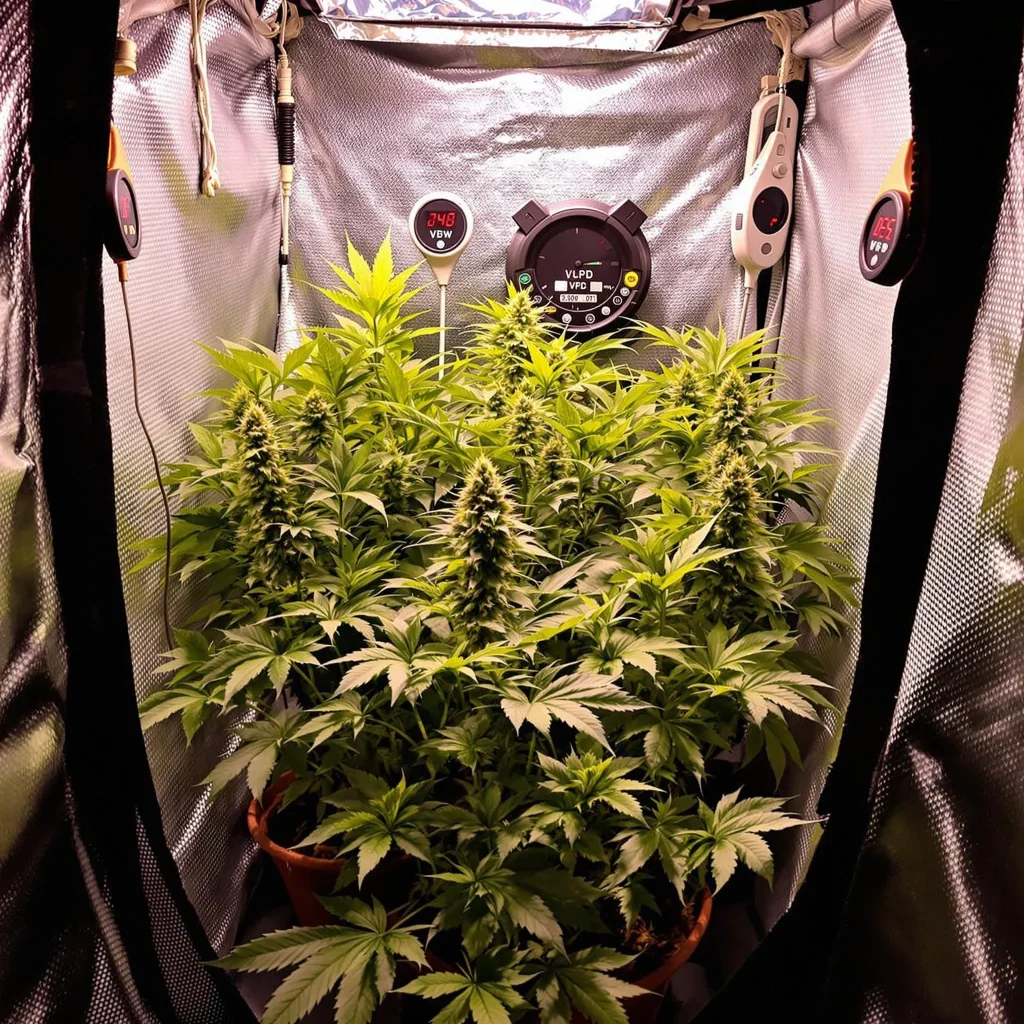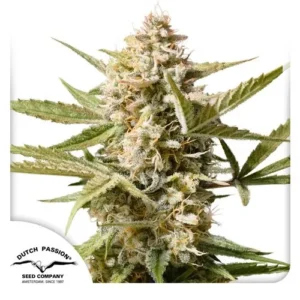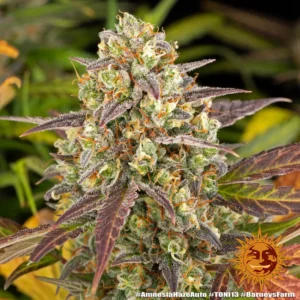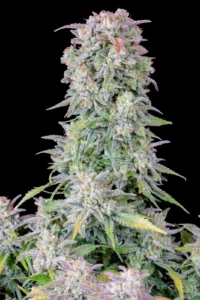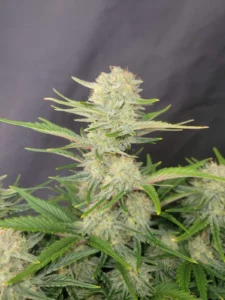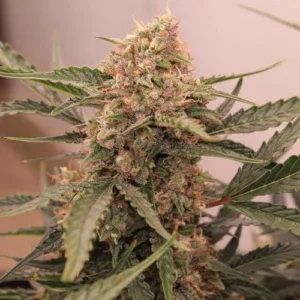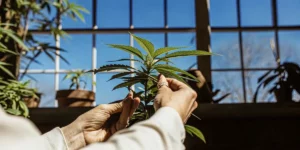Autoflower VPD Chart
What Is VPD and Why Does It Matter for Autoflowers?
Vapor Pressure Deficit (VPD) measures the difference between the moisture content in the air and the maximum amount of moisture the air can hold at a given temperature. This measurement directly affects how well autoflowers transpire, absorb nutrients, and develop. Maintaining the correct autoflower VPD chart is essential for improving plant health, optimizing yields, and preventing common growing issues such as mold, slow growth, or nutrient deficiencies.
VPD plays a critical role in controlling how much water a plant pulls from its roots and how effectively it can utilize those nutrients for growth. If the air is too dry, plants will transpire excessively, leading to dehydration and slowed photosynthesis. Conversely, if humidity is too high, plants will struggle to release moisture, causing nutrient lockout, slow transpiration, and potential fungal issues. Understanding VPD is key to fine-tuning your grow environment and ensuring your autoflowers flourish at every stage.
Recommended Strains
Auto Cinderella Jack
|
|
THC | 20% - 25% (Medium) |
|
|
Lineage | (Cinderella 99 X Jack Herrer) X Magnum |
|
|
Type | Autoflowering |
|
|
Height | 3.28 ft | 1 m |
|
|
Yield | High |
|
|
Yield Indoor | 1.64 oz/ft² | 500 g/m² |
|
|
Yield Outdoor | 5.29 oz/plant | 150 g/plant |
|
|
Life Cycle | 10 - 11 weeks |
|
|
Phenotype | 50% Indica / 50% Sativa |
|
|
Effects | Powerful, Relaxed |
|
|
Flavors | Incense, Earthy |
Auto Amnesia Haze
|
|
THC | 22% - 23% (Medium) |
|
|
Lineage | Amnesia Haze x BF Super Auto #1 |
|
|
Type | Autoflowering |
|
|
Height | 3.94 ft | 1.2 m |
|
|
Yield | High |
|
|
Yield Indoor | 1.64 - 1.97 oz/ft² | 500 - 600 g/m² |
|
|
Yield Outdoor | 8.11 - 10.58 oz/plant | 230 - 300 g/plant |
|
|
Life Cycle | 9 - 10 weeks |
|
|
Phenotype | 20% Indica / 80% Sativa |
|
|
Effects | Creative, Euphoric, Happy |
|
|
Flavors | Lemon, Citrus, Fruity, Earthy, Pine |
How VPD Affects Autoflower Growth and Yield
Autoflowers have a fixed lifecycle, meaning every stage of their growth must be optimized to ensure they reach their full potential before flowering. If the VPD is too high, plants close their stomata to prevent excessive water loss, which can reduce photosynthesis and stunt growth. If VPD is too low, plants struggle to release moisture efficiently, increasing the risk of mold and nutrient lockout. By maintaining an optimal VPD range, autoflowers grow healthier, stronger, and produce higher yields.
Correct VPD levels help your autoflowers take up CO2 more efficiently, which directly affects the rate of photosynthesis and energy production. This process allows autoflowers to achieve optimal growth within their short lifespan, making every day of their cycle count. Proper VPD also ensures that your plants can handle stress, such as minor temperature fluctuations or occasional changes in feeding schedules, without negatively impacting their yield potential.

The Ideal VPD Range for Autoflower Plants
To maximize growth, autoflowers require different VPD ranges depending on their stage of development:
- Seedling Stage: 0.5 – 0.7 kPa
- Vegetative Stage: 0.7 – 1.0 kPa
- Flowering Stage: 1.0 – 1.4 kPa
By adhering to these ranges, growers can ensure their plants receive the perfect balance of temperature and humidity for maximum productivity. Keeping VPD within these ideal ranges helps autoflowers transition smoothly between stages, allowing for steady development and robust bud formation.
How to Use an Autoflower VPD Chart
Interpreting Temperature and Humidity Levels
An Autoflower VPD chart helps growers determine the correct temperature and humidity balance for their autoflowers. To use an autoflower VPD chart effectively:
- Measure Air Temperature: Use a digital thermometer to monitor your grow room.
- Measure Relative Humidity (RH): A hygrometer provides accurate RH readings.
- Find the Intersection: On the Autoflower VPD chart, locate where temperature and humidity intersect to determine your current VPD.
- Adjust Accordingly: Compare the reading with the ideal range for your plant’s growth stage and make necessary environmental adjustments.
- Monitor Consistently: VPD levels fluctuate throughout the day, so regular checks and adjustments will keep your plants thriving.
Adjusting Your Grow Room for Optimal VPD
To maintain the best VPD levels, make these adjustments:
- Increase Temperature: Use grow lights or heaters to raise heat levels if needed.
- Decrease Temperature: Fans and air conditioners can help cool the environment.
- Raise Humidity: Use a humidifier or misting system to add moisture to the air.
- Lower Humidity: Dehumidifiers and better air circulation help reduce excess moisture.
- Improve Airflow: Oscillating fans prevent stagnant air, which can cause fluctuations in VPD.
Making fine adjustments to airflow, temperature, and humidity levels throughout different times of the day helps maintain a stable environment and prevents sudden VPD drops or spikes that could negatively affect plant growth.
Common Mistakes When Using a Autoflower VPD Chart
Many growers make errors when implementing VPD strategies. Avoid these common mistakes:
- Ignoring Leaf Temperature: Air temperature alone doesn’t give the full picture; using an infrared thermometer to check leaf temperature ensures accuracy.
- Overlooking Equipment Maintenance: Regularly calibrate thermometers and hygrometers for accurate readings.
- Failing to Adjust for Growth Stages: Autoflowers have different VPD needs at each stage, so adjust settings accordingly.
- Neglecting Air Exchange: Poor ventilation can lead to stale air buildup, affecting VPD and CO2 uptake.
Best VPD Settings for Autoflower Growth Stages
VPD for Seedling Stage: Ensuring Strong Roots
Seedlings require a humid environment to develop strong roots. Maintain:
- Temperature: 70-75°F (21-24°C)
- Humidity: 65-70%
- VPD: 0.5 – 0.7 kPa
High humidity reduces transpiration stress, allowing young plants to establish a solid root system before rapid vegetative growth. Proper hydration at this stage is crucial to setting the foundation for strong stems and foliage development.
VPD for Vegetative Growth: Maximizing Development
As autoflowers enter vegetative growth, they require slightly lower humidity to promote leaf and stem expansion. Ideal conditions:
- Temperature: 72-78°F (22-25°C)
- Humidity: 50-60%
- VPD: 0.7 – 1.0 kPa
Balancing these factors supports efficient nutrient absorption and prevents mold or mildew issues. This stage is where the most rapid growth occurs, so keeping VPD steady ensures robust plant structure, setting up for optimal bud production in flowering.
VPD for Flowering Stage: Enhancing Bud Production
During flowering, humidity should be reduced to prevent mold and enhance resin production. Target ranges:
- Temperature: 70-77°F (21-25°C)
- Humidity: 40-50%
- VPD: 1.0 – 1.4 kPa
A higher VPD in this phase encourages the plant to draw in more water and nutrients, which directly improves bud size and potency. Proper VPD at this stage ensures dense, trichome-rich buds with minimal risk of rot or mildew.
Troubleshooting VPD Issues in Autoflowers
Low VPD Problems and How to Fix Them
Low VPD (excessive humidity, low temperature) can cause slow transpiration and nutrient deficiencies, leading to weak plant growth. When the humidity is too high, plants struggle to release moisture efficiently, reducing their ability to absorb nutrients from the roots. This results in stunted development, yellowing leaves, and a higher risk of mold formation. Autoflowers, with their short life cycle, are particularly vulnerable to slow growth, making it crucial to correct low VPD as soon as possible.
To fix low VPD issues, growers should focus on adjusting environmental conditions. Increase temperature by using heaters or stronger grow lights to create a drier atmosphere. Improve ventilation by using exhaust fans to remove excess humidity, ensuring fresh airflow. Lower humidity by using dehumidifiers or increasing airflow with oscillating fans. Keeping a stable environment ensures your autoflowers transpire efficiently, leading to better nutrient uptake and healthier plants.
High VPD Issues and Their Impact on Autoflowers
High VPD (low humidity, high temperature) forces autoflowers to transpire excessively, leading to rapid water loss. This stresses the plant, causing leaf curling, drooping, and overall dehydration. In extreme cases, prolonged high VPD can stunt plant growth and lower bud production, significantly impacting yields. Additionally, excessive transpiration can result in nutrient imbalances, as plants absorb water faster than they take in essential minerals, leading to deficiencies.
To address high VPD problems, lower temperature using air conditioners or adjusting grow light intensity to prevent excessive heat. Increasing humidity by introducing humidifiers or placing water trays in the grow room helps slow down transpiration. Slower airflow is also beneficial; reducing fan speed prevents moisture from being stripped from the leaves too quickly. Keeping humidity and temperature within ideal VPD ranges allows autoflowers to grow stress-free, maximizing their potential.
Balancing VPD for Maximum Autoflower Health
To ensure autoflowers remain healthy and productive, growers must maintain stable VPD conditions throughout the plant’s life cycle. Monitoring VPD levels daily helps detect fluctuations that could negatively impact plant growth. Even small changes in humidity and temperature can affect transpiration rates, so having precise control over the environment is key. Adjustments should be made gradually to avoid shocking the plant, which could slow growth.
Using smart climate controllers can automate humidity and temperature adjustments, ensuring consistency in your grow space. These devices regulate conditions in real time, preventing extreme fluctuations. Additionally, growers should adjust VPD based on the plant’s growth stage. Seedlings need a more humid environment, while flowering plants thrive in lower humidity levels. Proper VPD management leads to healthier, more resilient autoflowers that produce higher yields.
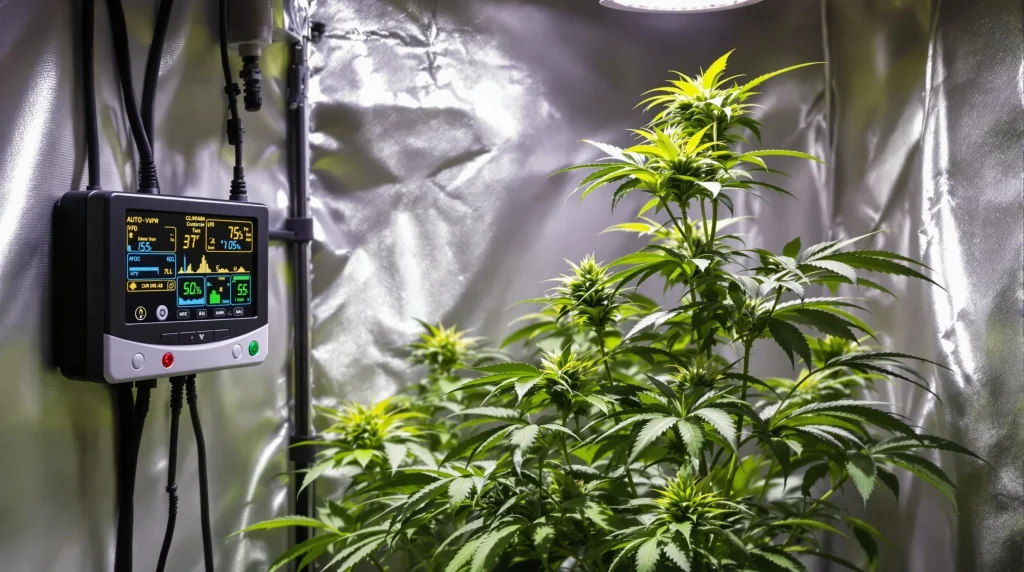
FAQs About Autoflower VPD Chart
What is the best VPD range for autoflowers?
The best VPD range for autoflowers varies depending on their growth stage. For seedlings, aim for 0.5 – 0.7 kPa to encourage root development. During the vegetative phase, a VPD of 0.7 – 1.0 kPa supports strong growth. In the flowering stage, maintain a VPD of 1.0 – 1.4 kPa to enhance bud production and resin development. Keeping VPD within these ideal ranges optimizes plant health and yield potential.
How do I measure VPD in my grow space?
To measure VPD accurately, you need to monitor both temperature and relative humidity. Use a digital thermometer to track air temperature and an accurate hygrometer to measure humidity levels. Some growers use infrared thermometers to measure leaf temperature, which provides a more precise VPD calculation. Autoflower VPD charts or online calculators can help interpret your readings, allowing you to adjust environmental conditions as needed.
What happens if my VPD is too high or too low?
If VPD is too high, plants lose water too quickly, leading to dehydration, leaf curling, and nutrient deficiencies. If VPD is too low, plants struggle to release moisture, reducing nutrient uptake and increasing the risk of mold. Both extremes stunt growth and lower yields. Regular monitoring and adjustments ensure VPD stays within the ideal range, promoting healthy transpiration and strong plant development.

